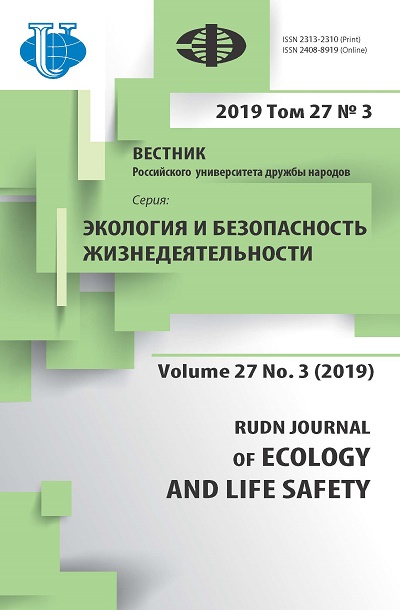Occupational air negative impacts on the workers at the light industry manufactures
- Authors: Gutorova N.V.1, Tikhonova N.S.1, Sedlyarov O.I.1
-
Affiliations:
- Russian State University named after A.N. Kosygin (Technologies. Design. Art)
- Issue: Vol 27, No 3 (2019)
- Pages: 199-208
- Section: Life Safety
- URL: https://journals.rudn.ru/ecology/article/view/23909
- DOI: https://doi.org/10.22363/2313-2310-2019-27-3-199-208
Cite item
Full Text
Abstract
Creating favorable work conditions is one of the most important priorities in the modern industry production. Observed in the recent years light industry manufacture growth is followed by a negative impact on the occupational air in industrial spaces and thus proves relevance of this research. The purpose of this work is to determine the characteristics of the formation of the occupational air and its impact on workers, taking into account the specifics of light industry production. Investigations of the temperature-humidity of the air state were carried out by the method of full-scale instrumental measurements of the occupational air. A feature of the research is that the measurements were carried out at a significant number of modern operating enterprises during the certification of work places with the involvement of laboratories accredited by the Russian Federation Oversight Committee for Sanitation and Epidemiology. The result of this article is a definition of jobs and areas that do not meet regulatory requirements. General recommendations are given to reduce the negative factors of the indoor air and their impact on the workers.
About the authors
Natalya V. Gutorova
Russian State University named after A.N. Kosygin (Technologies. Design. Art)
Author for correspondence.
Email: natofromoz@gmail.com
SPIN-code: 2355-6267
Candidate of Technical Sciences, Associate Professor, Department of Energy Resource Efficient Technologies, Industrial Ecology and Safety
33 Sadovnicheskaya St, bldg. 1, Moscow, 115035, Russian FederationNadezhda S. Tikhonova
Russian State University named after A.N. Kosygin (Technologies. Design. Art)
Email: 1035446@mail.ru
SPIN-code: 5444-1136
Candidate of Technical Sciences, Associate Professor, Associate Professor, the Department of Energy Resource Efficient Technologies, Industrial Ecology and Safety
33 Sadovnicheskaya St, bldg. 1, Moscow, 115035, Russian FederationOleg I. Sedlyarov
Russian State University named after A.N. Kosygin (Technologies. Design. Art)
Email: 7730719@mail.ru
SPIN-code: 5615-8146
Candidate of Technical Sciences, Associate Professor, Head of the Department of Energy and Resource Efficient Technologies, Industrial Ecology and Safety
33 Sadovnicheskaya St, bldg. 1, Moscow, 115035, Russian FederationReferences
- Russia in figures. 2018. Short statistical book. Moscow, Rosstat Publ.; 2018.
- Russia in figures. 2017. Short statistical book. Moscow, Rosstat Publ.; 2017.
- Russia in figures. 2016. Short statistical book. Moscow, Rosstat Publ.; 2016.
- Russia in figures. 2015. Short statistical book. Moscow, Rosstat Publ.; 2015.
- Russian Statistics Yearbook. 2014. Statistical book. Moscow, Rosstat Publ.; 2015.
- MUK 4.3.2756-10. Guidelines for the measurement and evaluation of the microclimate of industrial premises (approved by Chief State Sanitary Doctor of the Russian Federation, 12.11.2010). Available from: https://base.garant.ru
- SanPiN 2.2.4.548-96. Hygienic requirements to occupational microclimate (approved by the Russian Federation Oversight Committee for Sanitation and Epidemiology, 01.10.1996). Moscow, Information and Publishing Centre of Ministry of Health of the Russian Federation; 1997.
- SanPiN 2.2.4.3359-16. Sanitary and epidemiological requirements for physical factors in the workplace (approved by Chief State Sanitary Doctor of the Russian Federation, 21.06.2016). Available from: https://base.garant.ru
- Gutorova NV, Tikhonova NS. Simulation of the tannery microclimate. Design and Technology. 2018;(65):69–75.
















